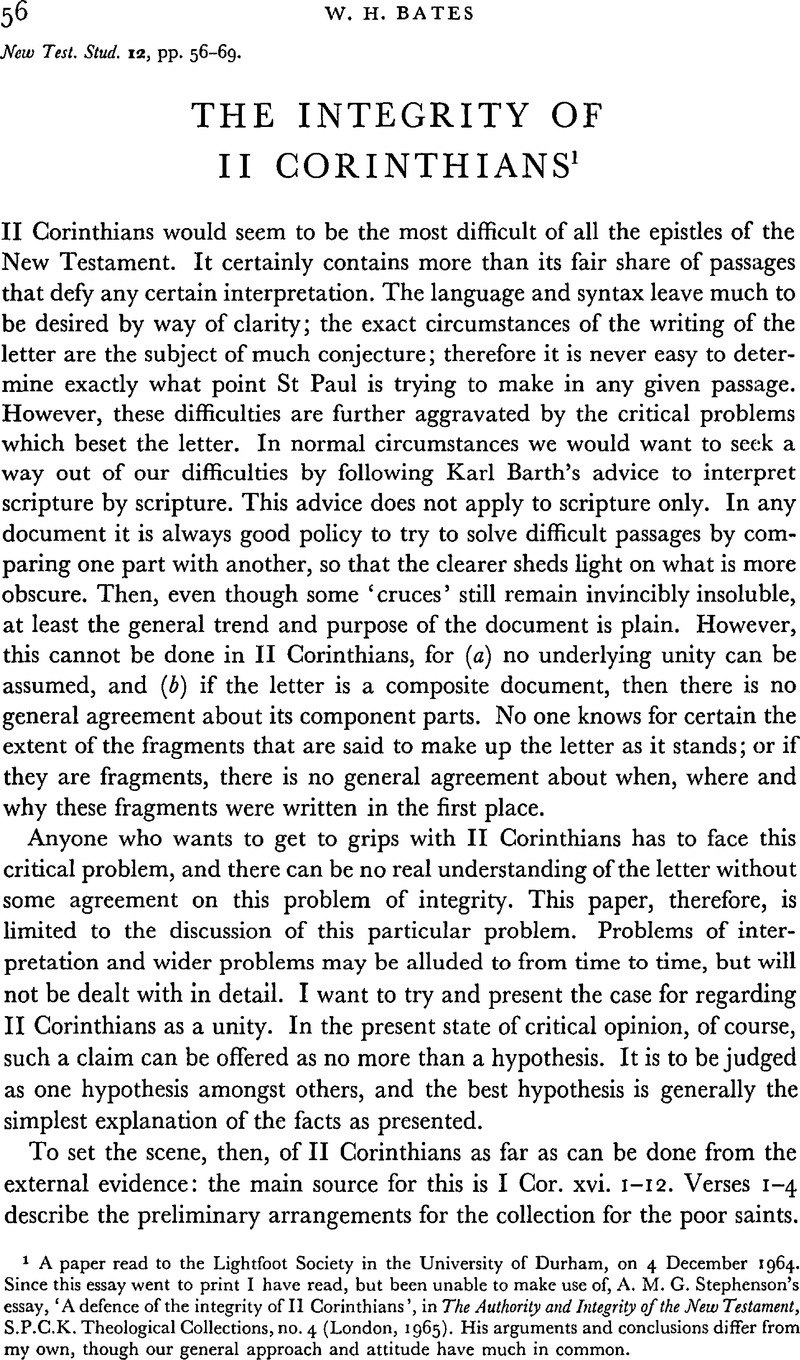Article contents
The Integrity of II Corinthians1
Published online by Cambridge University Press: 05 February 2009
Abstract

- Type
- Short Studies
- Information
- Copyright
- Copyright © Cambridge University Press 1965
References
page 57 note 1 I Cor. iv. 17; xvi. 10.Google Scholar
page 57 note 2 viii. 6.
page 57 note 3 viii. 17.
page 57 note 4 xii. 14; xiii. I.
page 57 note 5 ii. I.
page 57 note 6 Rom, . xv. 25; xvi. 23.Google Scholar
page 57 note 7 ii. 5; vii. 2.
page 57 note 8 ii. 9; vii. 8.
page 57 note 9 Duncan, G. S., St Paul's Ephesian Ministry (London, 1929).Google Scholar
page 58 note 1 Manson, T. W., Bulletin of the John Rylands Library, XXXIII, no. I (1939), and XXVI, no. 1 (1941).Google Scholar
page 58 note 2 I Cor. v. 9 shows that I Corinthians was not the first letter which the Corinthians had received from Paul after his departure. Nothing of this letter survives, except possibly in II Cor. vi. 14–vii. I. A certain amount of time, therefore, must be allowed to have elapsed between St Paul's arrival in Ephesus and the writing of I Corinthians.
page 58 note 3 Phil, . ii. 19, 24.Google Scholar
page 58 note 4 Phil, . iii. 2ff.Google Scholar
page 58 note 5 Gal, . i. 6.Google Scholar
page 59 note 1 Acts xix. 10.
page 59 note 2 x. 2.
page 59 note 3 xi. 5, 13–15.
page 59 note 4 xi. 18ff.
page 59 note 5 xii. 1ff.
page 59 note 6 xii. 12.
page 59 note 7 xi. 17; xii. 16.
page 60 note 1 x. 1; Xiii. 1–2, 10.
page 60 note 2 xii. 20; xiii. 5.
page 60 note 3 xii. 5, 9.
page 60 note 4 xii. 10; xiii. 9.
page 60 note 5 Pp. xxx–xxxvi.
page 61 note 1 Hermathena, xn (1903), 343.Google Scholar
page 62 note 1 I See Rom, . xv. 24–8.Google Scholar
page 63 note 1 Manson cites, with complete approval, the work of Kennedy, J. H., The Second and Third Epistles of St Paul to the Corinthians. Studies in the Gospels and Epistles (Manchester, 1962), p. 210.Google ScholarBulletin of the John Ryland's Library, XXVI (1942), 327.Google Scholar
page 63 note 2 I have not attempted to provide a full discussion of these verses, in a paper dealing mainly with the acceptability of the four chapters hypothesis. Clearly they break the sense between vi. 13 and vii. 2, and it is often argued that these verses are a fragment, not of the severe letter, but of the letter mentioned in I Cor. v. 9. On the other hand it is very difficult to explain why these verses should have been interpolated just here, and it is suggested that St Paul is here making an impassioned ‘aside’ to turn the Corinthians from that attitude which prevents them from giving him a fair hearing. Whatever the solution, it is doubtful whether the possibility that these verses may be an interpolation can be used as the thin end of a wedge to split open the integrity of the epistle.
page 63 note 3 English translation (New York, 1959), II, 348ff.Google Scholar
page 63 note 4 ii. 17.
page 63 note 5 Vi. 11–13; Vii. 2–4.
page 63 note 6 iii 1–18.
page 63 note 7 iv. 3.
page 64 note 1 iv. 7–11.
page 64 note 2 v. 12–19; vi. 4ff.
page 64 note 3 xi. 7–12; xii. 16–18.
page 64 note 4 xi. 8, 23.
page 64 note 5 xii. 9.
page 65 note 1 Op. Cit. p. 172.Google Scholar
page 65 note 2 Op. cit. p. 353.Google Scholar
page 63 note 1 Rom, . xvi. 22.Google Scholar
page 63 note 2 xi. 4, cf. Gal, . i. 6.Google Scholar
page 63 note 3 See chapter iii.
page 67 note 1 vii. 7.
page 67 note 2 vii. 13ff.
page 67 note 3 ii. 7.
page 68 note 1 i. 23.
page 69 note 1 Acts xx. 1–4.
page 69 note 2 Rom, . xv. 31.Google Scholar
- 1
- Cited by


